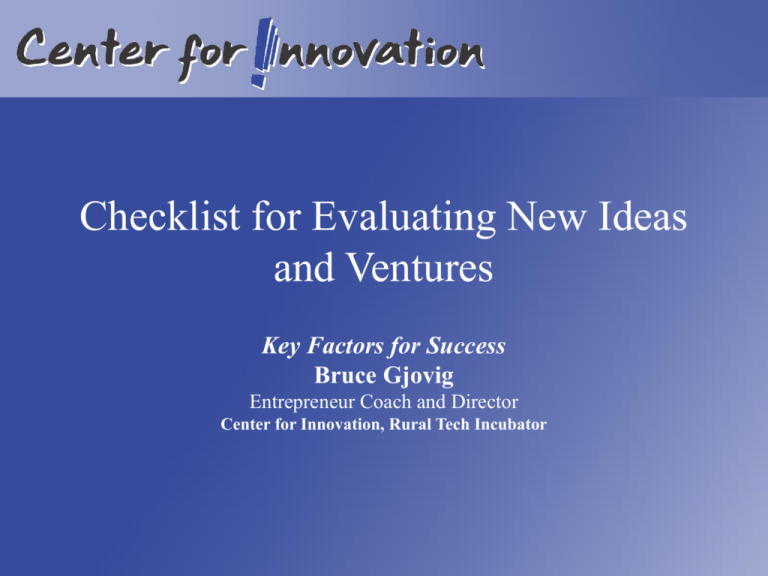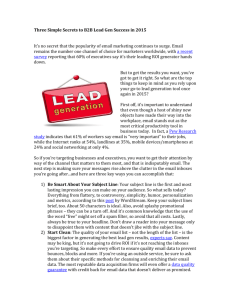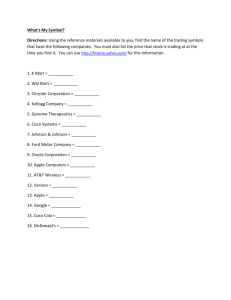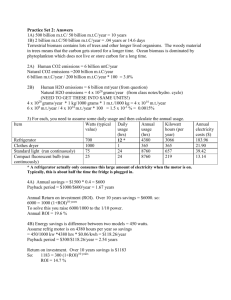Checklist for Evaluating New Ideas and Ventures
advertisement

Checklist for Evaluating New Ideas and Ventures Key Factors for Success Bruce Gjovig Entrepreneur Coach and Director Center for Innovation, Rural Tech Incubator TECHNICAL EVALUATION • • • • • • • • Innovative product, not “me too” Competitive advantages, features, and benefits Barriers to competitive entry (hard to imitate) High quality Third-party test results Ability to deliver a consistent, quality product on time Spin-off, different market applications Environmentally safe No safety/health risks, regulatory control MARKET EVALUATION • Competitive advantage • “USP”: Unique Selling Proposition Differentiate on quality, service, or innovation • Market Pull vs. Market Push Solves customer problems • Sunrise vs. Sunset market MARKET EVALUATION CONTINUED • • • • • Significant market niche Market plan/strategy Distribution channels available Repeat sales likely Year-round vs. Seasonal demand Approaches to Differentiation Prestige – Rolex, Mont Blanc Quality – Honda, Cadillac Top-of-the-Line image – Ralph Lauren, Cross Pens Innovative, technological leadership – 3M Corp. Engineering design and performance – Mercedes Approaches to Differentiation Continued A different taste – Dr. Pepper, Listerine Product reliability – Johnson & Johnson baby products Superior service – Federal Express Full range of services – Merrill Lynch Complete line of products – Campbell’s Soups Spare parts availability - Caterpillar Approaches to Differentiation Continued More for your money – McDonald’s, Wal-Mart Special features – Jenn-air’s indoor cooking tops Economy – GE’s miser light bulbs ECONOMIC EVALUATION Premium, price possible for quality Competing on innovation, quality & service - not price Low up-front investment intensity Low overhead High value-added Business plan ECONOMIC EVALUATION CONTINUED High productivity Minimum product liability Owners have financial commitment Management paid for performance, not title High Return on Investment (ROI) Realistic financial projections Good margins & profitability Good cash flow MANAGEMENT EVALUATION (The most important criteria) • Experienced in industry • Entrepreneurial aptitude and attitude Results-oriented, bias for action • Business experience and education • Visionary leadership – sees “big” picture • Business strategy is clear and concise MANAGEMENT EVALUATION (The most important criteria) • “Team” has experience and depth (Production, engineering, finance, marketing, management) • Experienced consultants, advisors (Technical, business, legal, accounting) • Outside accountability Board of Directors, investors, etc. Five-Year Profitable Survival of New Business Profitable Inexperienced, uneducated 8% 62% 30% Inexperienced, educated 25% Experienced, uneducated 25% Experienced, educated Experienced, educated, planned 29% 23% 61% 81% 46% 52% 16% 12% Marginal 25% 7% Failed RELATIVE MARKET SHARE IS CLOSELY RELATED TO PROFITABILITY 40% 35% 30% ROI (%) 25% 20% 34% 15% 10% 5% 11% 11% 0 16 20% 20% 30 45 0% 80 Relative Market Share (%) High Market Share Increases ROI ROI INCREASES WITH MARKET SHARE RANK 35 30 ROI (Pretax) 25 20 15 10 5 0 #5 #4 #3 #2 Market Share Rank #1 Higher Market Share Increases ROI Profit (Pre-Tax, pre-interest) 35 30 Percent 25 20 ROS ROI 15 10 5 0 20 40 60 80 Relative Qualtity (percentile) 100 Quality Increases Rate of Return HIGH QUALITY PRODUCTS & SERVICES ARE MOST PROFITABLE (Less 12% cst of cap.) 30% 29% 25% 21% 20% ROI(%) 18% 18% 15% 10% 10% 5% 0% 0 5 25 50 Perceived Quality By Competition Quality Increases Rate of Return Quality Customer Service Based on 3,000 businesses in all sectors of the economy. --Strategic Planning Institute, Cambridge, MA Low Service High Service Difference Price Index 98% 107% 9% Annual Market Share Shift Profitability -2% +6% 8% +1% 12% 11% Pay for Quality Customers will pay: 33% more for a higher quality car 50% more for a higher quality dishwasher 65% more for a better TV 70% more for a better sofa 100% more for better shoes Gallup Surveys for American Society for Quality Control Definition of “Quality” • • • • The customer’s judgment, not yours Both the product and the associated services Not absolute, but relative to competitors Does not include price Quality Index = Percent of sales from superior minus Percent of sales from inferior products GOOD PRODUCTIVITY IS CLOSELY TIED TO HIGH ROI 35 30 25 20 ROI (%) 15 10 5 0 25K 30K 35K 50K Value Added Per Employee High Productivity Increases Profitability PERCENT CAPITAL INTENSITY HURTS PROFITABILITY 45 40 35 30 25 20 15 10 5 0 ROS ROI 0 20 60 80 100 Investment/Sales (%) ROI (%) AS INVESTMENT INTENSITY RISES ROI DECLINES 0.4 0.35 0.3 0.25 0.2 0.15 0.1 0.05 0 36% 26% 21% 15% 9% 0 36 46 58 72 Investment/Sales (%) Capital Intensity Decreases Profitability Major Factors Causing High Profits 1. Strong Market Position Relative Market Share > 80% 2. Low Investment Intensity Investment/Sales < 33% 3. High Productivity Value Added/Employee > $60 K 4. High Perceived Quality Quality > 50% 5. Low R&D Marketing Expense Marketing + R&D/Sales < 10% Major Factors Causing Profit Trouble 1. Weak Market Position Relative Market Share < 25% 2. High Investment Intensity • Fixed Capital Investment/Sales < 33% • Working Capital or Investment/Sales > 70% 3. Low Productivity Value Added/Employee < $45K 4. Poor or Standard Quality Quality < 0 5. High R&D & Marketing Expense Marketing + R&D/Sales > 15% Percentage of New Produce Failures For Three Types of Businesses: Consumer, Industrial, Service Survey Source & Year All Products Consumer Industrial Service Booz, Allen & Hamilton (1968) 37% 35% -- Advertising Age (1969) 80% -- -- The Conference Board (1971) 40% 20-40% 10-20% Nielson (1971) 53% -- -- Journal of Marketing (1971) 65% -- -- Grand Average 55% 33% 15% Percentage of New Produce Failures For Three Types of Businesses: Consumer, Industrial, Service Survey Source & Year All Products Consumer Industrial Service The Conference Board 40% 42% 38% 10-20% Booz, Allen & Hamilton 35% -- -- -- Assn. of Natl. Advertisers -- 39% -- -- Gallagher -- 36% -- -- Cooper -- -- 24% -- Grand Average 38% 39% 31% 15% Product Lifecycle • • • • • • 17-20 years – 1970 10-20 years – 1980 5-6 years – 1990 2-3 years – 2000 Less than 1 year for some products Need for constant innovation, improvement, new product development 3M • 30% of sales from products introduces within last 5 years • 10% real growth annually • 10% profitability after taxes • 27% return on capital investment • 15% rule of time New Products • • • • Need a champion Market test Get to market swiftly (market plan) First to market gains share, higher margins, etc. • Sell benefits, not features • Unique benefits – innovative, better, faster, etc. • Some 37% of U.S. households include someone who has founded, tried to start or helped fund a small business. - Entrepreneurial Research Consortium Small Business Success… 70% going after 8 years -Dun& Bradstreet survey of 800,000 small businesses started in 1985 80% fail in 5 years is myth! “Every Community will lose about 10% of its jobs each year – from acquisition, downsizing, death, retirements or other causes. About 55% of all new jobs are from expansions of existing local companies and nearly 45% of new jobs are created by startup companies. Less then 1% of net new jobs occur as the result of relocations.” -David Birch, Ph.D. Cognetics “Fast growth companies that utilize university resources boast productivity rates 59% higher than peers without a university relationship, as well as 21% higher annual revenues and 23% more capital investments. Private/public collaboration provides a strategic advantage for a significant number of high growth companies.” -1995 Coopers & Lybrand Study Net new jobs come form… • • • • 66% employers of less than 20 80% employers of less than 100 50% less than 4 years old 1/3 generate 2/3 new jobs 80% of new sales High risk Economy Unemployment Low Real Wages – all time high Record Profits Export Growing 3x growth of economy BUT… 12% college graduates lost job since 1993 Corporate downsizing Job insecurity Economic uncertainty Growth Has been traded for Security Higher risk…higher reward Strategies for Workers… • High tech career -most growth, most turmoil • Exporting company -pays 12% more on average • Self-employed Strategies for companies… • Reengineer, restructure -boost productivity, profits -cut costs • Technological innovation • Export in growth countries • Invest in deregulated markets






